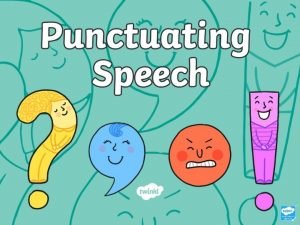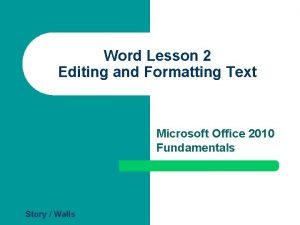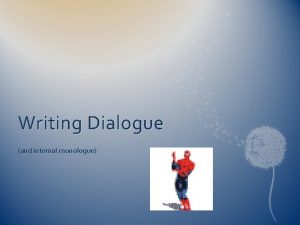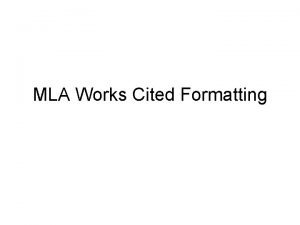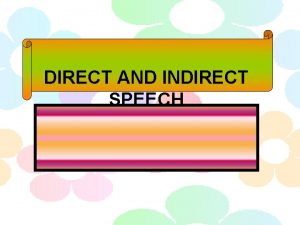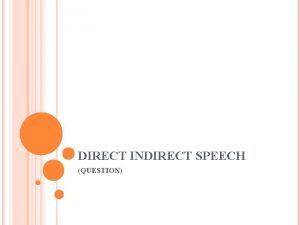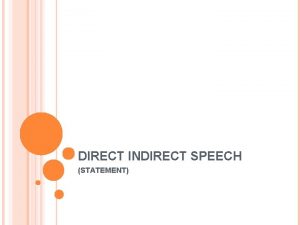Dialogue Direct indirect summary and formatting Dialogue Summary










- Slides: 10

Dialogue Direct, indirect, summary and formatting

Dialogue Summary Good dialogue should be believable but distilled: the kinds of things people like this would say, but with the filler and warm-up parts of a conversation taken out. Use dialogue summary to skip to the most important parts of a conversation. Summarized dialogue conveys the topics and maybe the tone, but not the exact words. You don’t use quotations marks because it’s not the exact words of the characters.

Dialogue summary example At home in the first few months, he and Maizie had talked brightly about changes that would make the company more profitable and more attractive to a prospective buyer: new cuts, new packaging, new advertising, new incentives to make supermarkets carry the brand. (Joan Wickersham, “Commuter Marriage”)

Indirect Speech Indirect speech allows characters to move in and out of their exact words freely without quoting. Example: Had he brought the coffee? She had been waiting all day long for coffee. They had forgot it when they ordered at the store the first day. Gosh, no, he hadn’t. Lord, now he’d have to go back. Yes, he would if it killed him. He thought though, he had everything else. She reminded him it was only because he didn’t drink coffee himself. If he did he would remember it quick enough.

Direct Quotation Use direct quotation if the scene contains discovery or decision and dramatic action. Quoting the exact words in a critical moment helps to draw the reader into the action as it unfolds. Keep in mind: dialogue should accomplish more than one thing. It should convey feelings and attitudes, and conflicts, not just plot information or backstory. For example, this little speech tells you about much more than Senator’s cousin and her life as a teenager: “I had a female cousin one time—a Rockefeller, as it happened—“ said the Senator, “and she confessed to me that she spend the fifteenth, sixteenth and seventeenth years of her life saying nothing but No, thank you. Which is all very well for a girl of that age and station. But it would have been a damned unattractive trait in a male Rockefeller. ”

Other Uses of Dialogue can set the mood through word choices: “I have a lousy trip to Philadelphia, lousy flight back, I watch my own plane blow a tire on closed-circuit TV, I go to my office, I find Suzy in tears because Warren’s camped in her one-room apartment. I come home and I find my wife hasn’t gotten dressed in two days. ” (Joan Didion, Book of Common Prayer)

Dialogue can Advance the Action “The surgeon will speak to you, ” says the Radiologist. “Are you finding something? ” “The surgeon will speak to you, ” the Radiologist says again. “There seems to be something there, but the surgeon will talk to you about it. ” “My uncle once had something on his kidney, ” says the Mother. “So they removed the kidney and it turned out the something was benign. ” The Radiologist smiles a broad, ominous smile. “That’s always the way it is, ” he says. “You don’t know exactly what it is until it’s in the bucket. ” “In the bucket, ” the Mother repeats. “That’s doctor talk, ” the Radiologist says. “It’s very appealing, ” says the Mother. “It’s a very appealing way to talk. ” (Lorrie Moore, “People Like That Are the Only People Here”)

Abuse of Dialogue Don’t load up the conversation with background facts that could easily be summarized or skipped (like dates and age, etc. ) Here’s and example of what NOT to do: “I’ve missed you so much, Margie! It’s been over a month since we ran into each other at the Farmer’s Market. That was the day you told me that your grandson Eddie got into Julliard!” “Yes, Suzie, and wasn’t that right before the tornado came through town? We were so scared when that siren went off! Remember how we hid underneath the table with the watermellons on it? ” This is just tedious as dialogue. If you want to tell readers the story of the tornado, just tell it; don’t weigh down dialogue with this backstory.

Text and Subtext Often the best dialogue is when the characters don’t directly say what they mean. People in extreme emotional states are usually pretty inarticulate. Plus, there is more tension in a love scene where the lovers are afraid to reveal their feelings than in one where they just say yes and jump in bed. As Janet Burroway says, “When an unspoken subject remains unspoken, tension continues to build in a story. Often the crisis of a story occurs when the unspoken tension comes to the surface and an explosion results. ” Jerome Stern suggests, “Once people are really candid, once the unstated becomes stated, the tension is released and the effect is cathartic. . . you want to give yourself the space for a major scene. ” But don’t do that until you’re ready and your readers are ready. It also helps develop relationship and tension when characters say “no” to each other, directly or indirectly.

General Guidelines Have your characters speak no more than three sentences uninterrupted unless you have a good reason to do otherwise. Keep exposition (telling what happens) out of dialogue. Let your characters sometimes conceal or avoid instead of saying exactly what they mean. Use “said” as a dialogue tag whenever possible. Don’t call attention to tags. Use an action rather than a modifier to show a character is feeling. Cut to the chase. Don’t use dialogue unless it moves the story forward and reveals character. No empty chat. Don’t let your characters be fully articulate in every moment. Fragments are fine. Stumbling, changing topic, avoiding questions, all help reveal a subtext.




